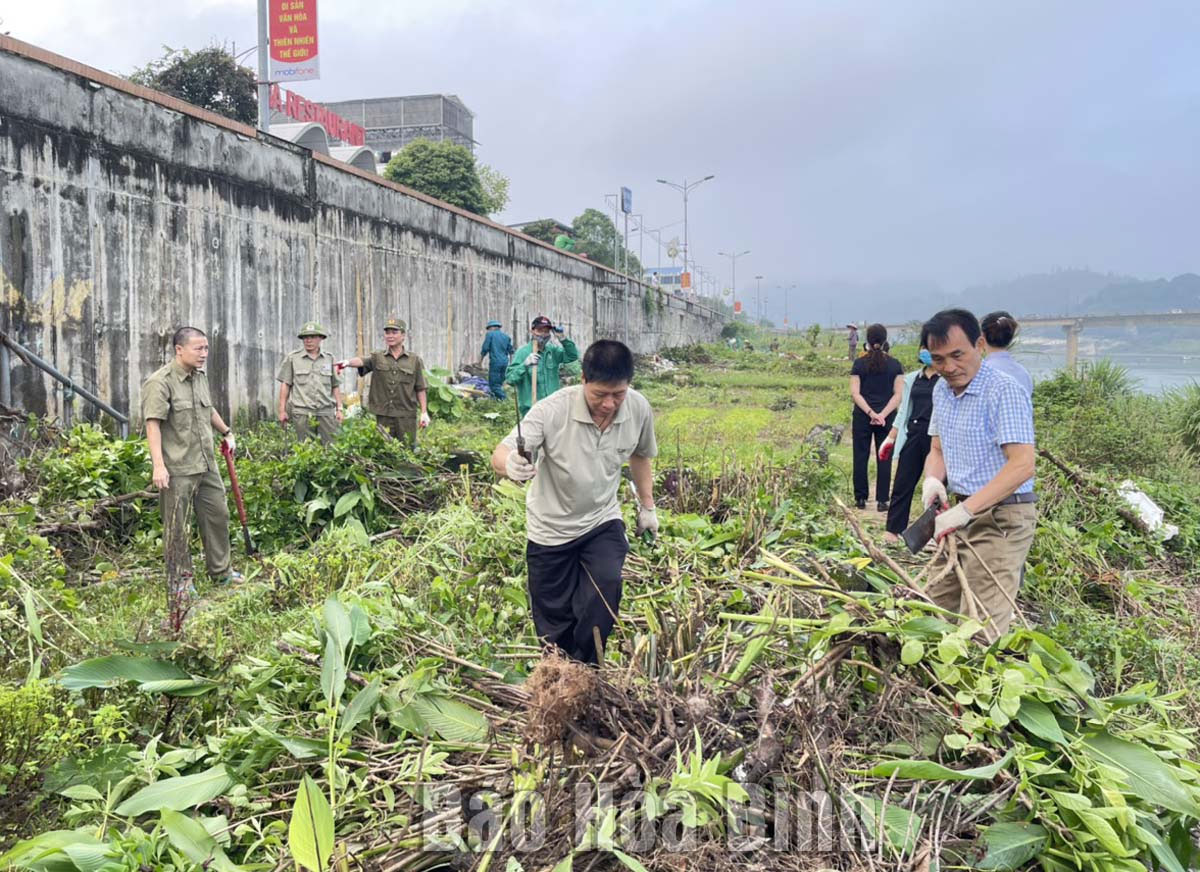
(HBO) – The Hoa Binh provincial People’s Committee issued Decision No 1966/QĐ-UBND on September 9, 2022, that approved a plan to develop the nigh-time economy in Hoa Binh city. This plan will be carried out in Phuong Lam and Dong Tien wards, along the Da Giang dyke.
Cadres and residents in Dong Tien ward clean up the environment to ready the site for implementing the night-time economy plan in Hoa Binh city.
The plan aims to promote tourism and service sectors and create jobs for local people. It targets that production value in the trade, service and tourism sectors in the nigh-time economic zone will grow by 20% annually. Service and trade revenue in the zone is hoped to reach 500 billion VND (20 million USD) each year by 2023, accounting for 20 - 25% of the total in Phuong Lam and Dong Tien wards. The zone is expecting to attract 500,000 tourists per year while the length of visitors’ stay will extend, to 1.5 days among Vietnamese visitors and two days among foreigners.
Do Thi Loan, a cadre of the division for economic and infrastructure affairs of Hoa Binh city, said the city boasts sufficient infrastructure conditions for developing the nigh-time economy.
By the end of 2021, it had 1,279 enterprises, 62 cooperatives, and 7,644 business households, more than 50% of which engage in trade, services, transportation, and tourism. There are 379 establishments providing food and beverage services at present, including 10 restaurants eligible for receiving tourists and nearly 80 supplying night-time food and beverage services (after 8pm), mostly in Phuong Lam, Dong Tien, and Quynh Lam wards.
However, she also admitted the modest size and quality of those establishments, along with a lack of a concentrated and large night-time food zone.
To develop the night-time economy, the Hoa Binh municipal People’s Committee identified several tasks, including stepping up the dissemination of legal regulations on urban security and order, food safety, and environmental hygiene; boosting night-time economic activities in combination with safeguarding political security and social order and safety; increasing communications to raise service providers’ awareness of business ethics; forming the connectivity among stakeholders; and maximising functions of the night-time economic zone. Besides, authorities will also encourage local amateur singing and dancing teams to hold regular performances of traditional culture in the zone./.
Hoa Binh province is undergoing a dynamic transformation amid Vietnam’s national digital transition. Building on Poliburo’s Resolution No. 57-NQ/TW on breakthroughs in science, technology, innovation, and national digital transformation, the province has rolled out a wide range of practical action plans. A standout initiative is the "Digital Literacy for All” movement, an effort to ensure that no one is left behind in the digital era.
Hoa Binh province is undergoing a dynamic transformation in the wake of the national digital transformation movement. Building on Resolution No. 57-NQ/TW of the Politburo on breakthroughs in science, technology, innovation, and national digital transformation, the province has implemented a wide range of practical action plans. A standout initiative is the "Digital Literacy for All” movement ambitious effort to ensure that no one is left behind in the digital age.
With a spirit of unity and proactive problem-solving, the Party Committee, the government and the people of Dong Lai Commune (Tan Lac District) have made great strides in implementing the resolutions of the 24th Party Congress of the commune for the 2020 - 2025 term. Focusing on leadership and practical actions, the commune has brought the Party’s resolutions into daily life, creating strong impacts and pushing the local development forward.
Amid the nationwide push for digital transformation, young people in Hoa Binh Province are stepping up as dynamic pioneers, applying technology to enhance Youth Union operations and expand the reach of youth-led initiatives. Through creativity and adaptability, Youth Union organizations at all levels have introduced a series of practical solutions, contributing to modern governance and community development.
In recent years, An Nghia commune, located in Lac Son district, has stepped up administrative reform, focusing on improving the quality and efficiency of its single-window service unit for receiving and processing administrative procedures. These improvements have helped create favourable conditions for local residents and organisations to handle administrative procedures, contributing to the commune’s broader socio-economic development.
The Prime Minister-approved master plan to develop the multi-use value of forests ecosystems through 2030, with a vision to 2050, aims to improve the management and sustainable use of forest resources, create jobs, increase incomes, and improve the living standards of ethnic minorities, people in mountainous and remote areas, forest workers and those living near forests.



